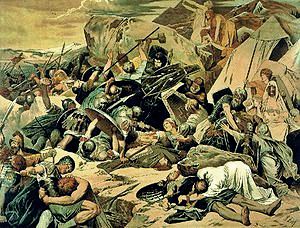
Battle of Mount Lactarius(Battle of Vesuvius or of Draco) |
year: 553late 552 or 553 |
| Terminal defeat of the Ostrogoths of Italy by the Byzantines under Narses | ★ ★ ★ ★ ★ |
|
enemy: Ostrogoths
|
location: Modern Monti Lattari in Campania, near Mt. Vesuvius, south of Naples, Italy.
|
accuracy:
●●●●●
|
|
battle type: Pitched Battle |
war: Gothic War in Italy (535–554) |
modern country:
Italy |
| ▼ The Byzantines(emperor: Justinian I) | ▼ The Enemies | |
| Commander: | General Narses | King Teia |
| Forces: | Unknown | Unknown |
| Losses: |
| Background story: |
| After the Battle of Taginae, in which the Ostrogoth king Totila was killed, the Byzantine general Narses captured Rome and besieged Cumae. After the death of Totila, Teia (apparently a military officer serving under Totila) was chosen as successor and raised over a shield. The new Ostrogothic king, gathered the remnants of the Ostrogothic army and marched to relieve the siege of Cummae, but in October of 552 (or early 553) Narses gathered his forces and waited for him at the southern foothills of Vesuvius, on the bank of the Draco river (now the Sarno, runs into the bay of Naples). |
The Battle: |
 Battle of Mount Lactarius They appeared so unexpectedly that the Romans had no time to take position in their regular array. The Goths had left their horses and advanced as a solid mass of infantry. The Romans received them in the same formation. In the battle there was no room for tactic, it was a sheer trial of personal strength, bravery, and skill. The Gothic king led the assault and he became the target for the Romans’ most dexterous lancers. It was a Homeric combat. Teia stood covered by his shield. At some point, there were twelve spears sticking in the shield of Teia, and he found he could not move easily. Without retreating a foot, he asked for a new shield. A new one was brought to him, but in the instant in which he was exchanging it for the old, his chest was exposed, and a lucky javelin wounded him mortally. The rest of the Goths continued to fight until nightfall and again the next day. Finally, seeing that there was no hope, negotiated with Narses their retirement outside Roman territory –with their belongings. Narses agreed and the battle ended. |
Aftermath: |
| This was the last major battle of the Gothic war. With this victory, the Byzantines prevailed in Italy, which, for a few decades, became part of the Roman empire again. |
|
|
